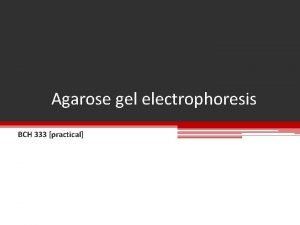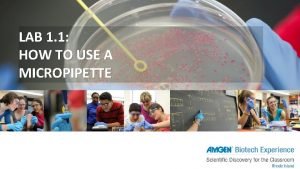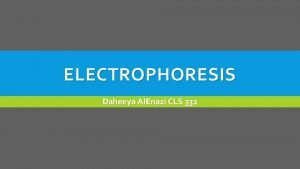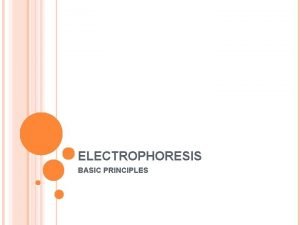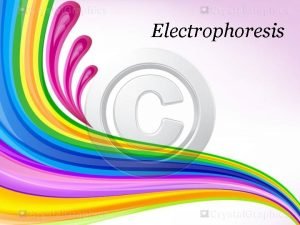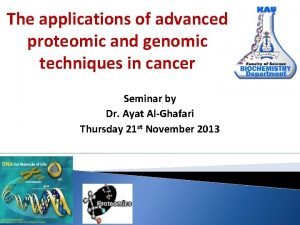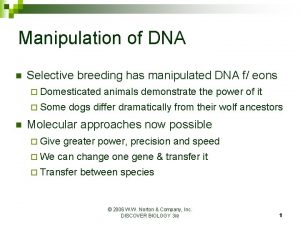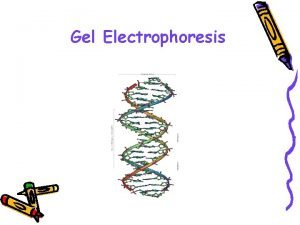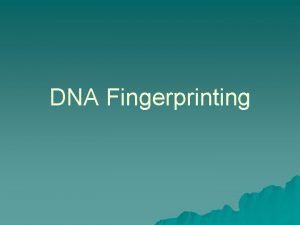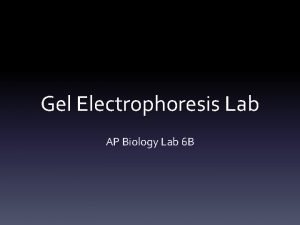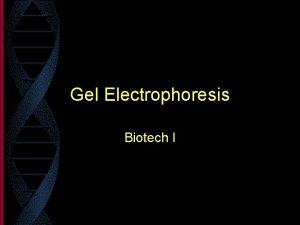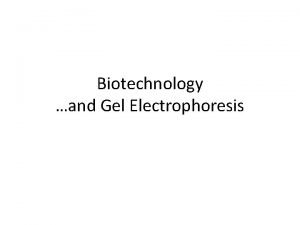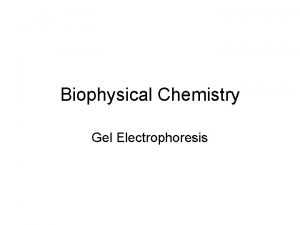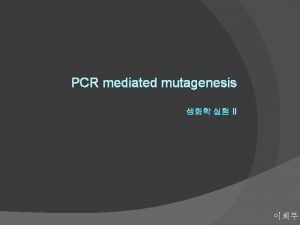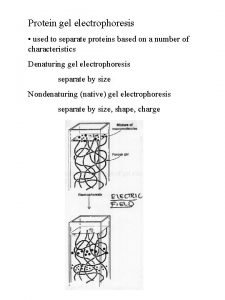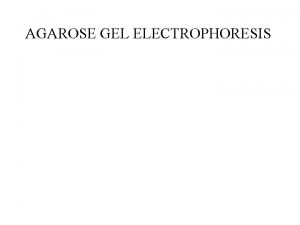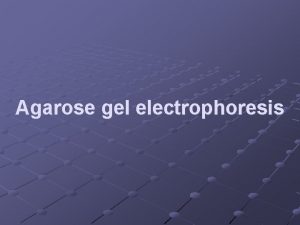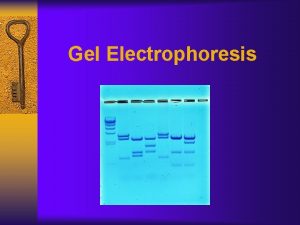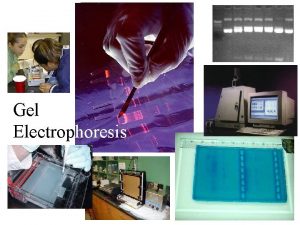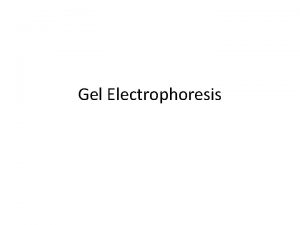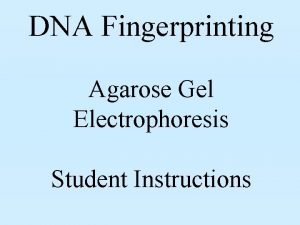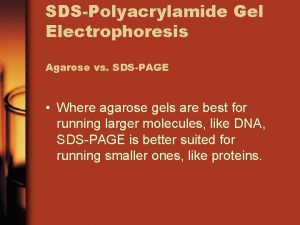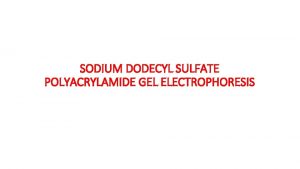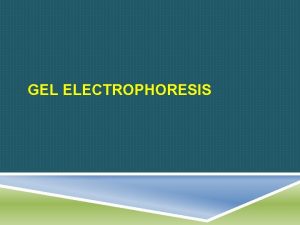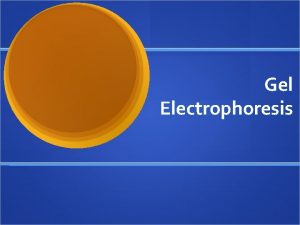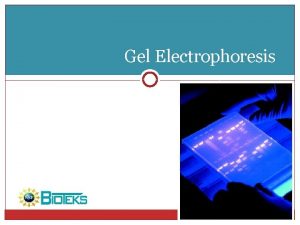Agarose gel electrophoresis Agar and agarose are derived


















- Slides: 18

Agarose gel electrophoresis Agar and agarose are derived from the cell walls of red algae Agar is a mixture of agarose and agaropectin agar-agar Malay name for red algae Photo by Matthew Kenwick (Flickr) Harvesting Gelidium red algae in Indonesia

Asian cuisine has made use of the unique gelling properties of agar for centuries Mizuyōkan Japanese dessert made of red bean paste, agar and sugar Gelling demonstrates hysteresis: Gel–to–solution transition occurs differently when the temperature is raised than when it is lowered Melts at 85 -90˚C Solidifies at 32 -40˚C

How are agarose gels made? How are agarose gels used to analyze DNA molecules? How can agarose gels be used to identify met deletion strains?

Chemistry of agarose gel formation Agarose is a linear polymer of a galactose-based disaccharide with a neutral charge As molten solution of agarose cools, polymers assemble into a gel 32 -40 ˚C 85 -90 ˚C Pore size depends on the concentration of agarose

Preparing the agarose solution Agar is combined with the appropriate volume of running buffer in a flask Flask is microwaved in 20 -30 second bursts, and swirled between bursts Stop heating when no solid pieces of agarose powder are visible Hot solution- beware of steam! Use a paper towel or other holder to handle the flask

Pour the gel When the flask is cool enough to handle comfortably, pour the gel Ends of gel tray should be taped or placed against a dam Caution: Gel apparatus is made of plastic – it can become deformed if solution is too hot

Form the sample wells Immediately after pouring the gel, place the sample comb in position Sample wells form around the teeth of the comb Allow the gel to thoroughly cure before removing the comb (gel will be opaque

Prepare the gel for electrophoresis Remove the dam from the gel (or vice versa) Orient the gel so that samples will run toward the positive pole Cover the gel completely with a few mm of running buffer Agarose gels are sometimes referred to as “submarine gels”

How are agarose gels made? How are agarose gels used to analyze DNA molecules? How can agarose gels be used to identify met deletion strains?

Loading the samples Samples are mixed with tracking dyes and glycerol Carefully pipet samples into the wells Common mistakes: Bubbles that cause samples to leak from the wells Puncturing the gel with the pipette tip

Start the electrophoresis Cover the apparatus with the top Attach the apparatus to the power supply with the correct polarity Turn on the power supply, and adjust the voltage (most likely 70 -100 volts) Caution: electrophoresis generates heat Excessive heat will reduce the resolution of your gel and may even melt it!

Be vigilant, but patient! Stop the gel when the bromophenol blue is ~2/3 down the gel xylene cyanol bromophenol blue Note that condensation increases over time due to the heat being generated

DNA molecules are visualized with fluorescent dyes that intercalate into the DNA helix Ethidium bromide (Et. Br) is a light-sensitive, water-soluble dye Fluorescence increases ~20 -fold when bound to DNA Caution: Gloves should be worn when handling Et. Br

Transilluminator and camera system are used to visualize DNA gels Et. BR absorbs ultraviolet light and emits visible light at ~500 nm Lift open the door and position the gel on the transilluminator Adjust the exposure and capture the image Turn on the UV light AFTER the door is closed

Lengths of DNA molecules can be estimated from their migration Log 10 fragment length (bp) Restriction digestion of bacteriophage lambda DNA generates a series of fragments that serve as useful size markers for gels Plotting the mobility of restriction fragments generates a standard curve that can be used to estimate DNA sizes from their migration on gels Distance migrated (mm)

How are agarose gels made? How are agarose gels used to analyze DNA molecules? How can agarose gels be used to identify met deletion strains?

Yeast colony PCR can distinguish wild-type and deletion alleles GSP Primer A 5'-flanking region Native chromosome Yeast ORF GSP Primer B GSP Primer A 5'-flanking region Recombinant chromosome Kan. R KANR Primer B Genomic DNA was used as a PCR template with a gene-specific (sense) primer A and either an antisense gene-specific primer or the KANR gene primer B The presence/absence as well as the size of the PCR product are useful in identifying strains

Group from a previous class successfully identified three met strains MW GSP/KANBR primers GSP A/B primers GSP-A and KAN-BR primers gave products of the expected sizes (lanes 2 -4) No products obtained with GSP-A and GSP-B primers (lanes 5, 7, 8) 564 bp Note staining of yeast colony DNA in sample wells! 1 2 3 4 5 6 7 8
 Agarose gel electrophoresis vs sds page
Agarose gel electrophoresis vs sds page Pipetting exercises
Pipetting exercises Disadvantages of agarose gel electrophoresis
Disadvantages of agarose gel electrophoresis Advantages of agarose gel electrophoresis
Advantages of agarose gel electrophoresis Agarose gel
Agarose gel Mikael ferm
Mikael ferm Basic principles of electrophoresis
Basic principles of electrophoresis Process of gel electrophoresis
Process of gel electrophoresis Translate
Translate Selective breeding definition biology
Selective breeding definition biology Electrolysis gel
Electrolysis gel Gel electrophoresis why do smaller fragments move faster
Gel electrophoresis why do smaller fragments move faster Gel electrophoresis separates dna by
Gel electrophoresis separates dna by Bio lab gel
Bio lab gel Is gel electrophoresis a biotechnology
Is gel electrophoresis a biotechnology Zone electrophoresis definition
Zone electrophoresis definition Gel electrophoresis definition
Gel electrophoresis definition Gel electrophoresis result
Gel electrophoresis result Procedure of sds page
Procedure of sds page
